 Having such fuzzy memories of American history lessons in school, I thought that Valley Forge marked some battle site or other from some war or other. A visit to this national park clarified things for me and captured my imagination more than I had anticipated. It is set in beautiful, gently rolling countryside that gives it a most park-like feeling, and in fact it was created a century after the events it commemorates specifically to look and feel like a park. With 26 miles of trails to explore, many visitors toured the site by bicycle and followed the looping route that we took by car. Note to my cyclist friends: on a good-weather day, Valley Forge seems to make for an absolutely splendid bike ride.
Having such fuzzy memories of American history lessons in school, I thought that Valley Forge marked some battle site or other from some war or other. A visit to this national park clarified things for me and captured my imagination more than I had anticipated. It is set in beautiful, gently rolling countryside that gives it a most park-like feeling, and in fact it was created a century after the events it commemorates specifically to look and feel like a park. With 26 miles of trails to explore, many visitors toured the site by bicycle and followed the looping route that we took by car. Note to my cyclist friends: on a good-weather day, Valley Forge seems to make for an absolutely splendid bike ride.
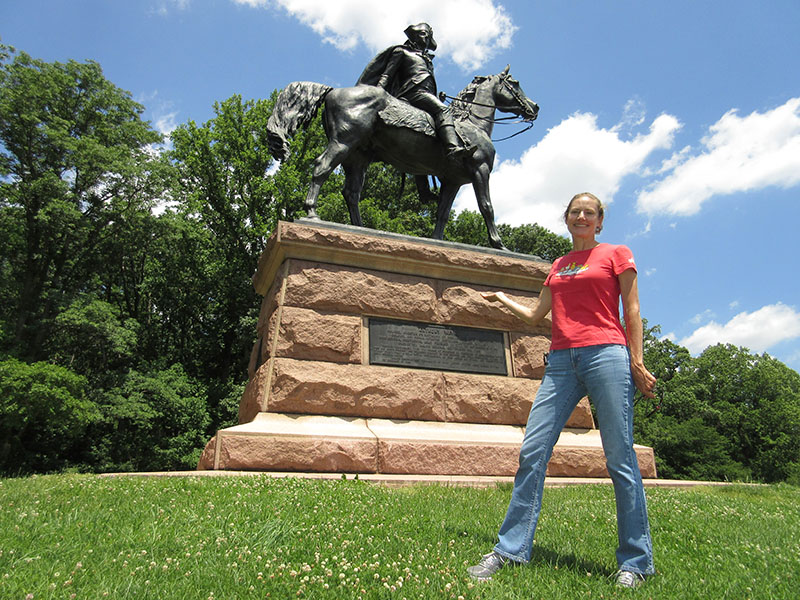
Valley Forge National Historical Park marks the location of the Continental Army’s winter encampment — less than 25 miles from British-occupied Philadelphia — from December 1777 to June 1778 during the Revolutionary War. It was one of eight winter camps throughout the war but perhaps the most interesting one. The park tells a fascinating story about life for the 12,000 soldiers who took over and temporarily devastated this agricultural valley along the Schuylkill River during a break in the fighting. They had to build their own huts and then endure a harsh winter of disease and deprivation while they waited for battle to resume. In the meantime, under Prussian Baron von Steuben, the soldiers underwent regimented training like they’d never seen before. Von Steuben turned the large ragtag force into an organized army capable of defeating the British (albeit five years later).
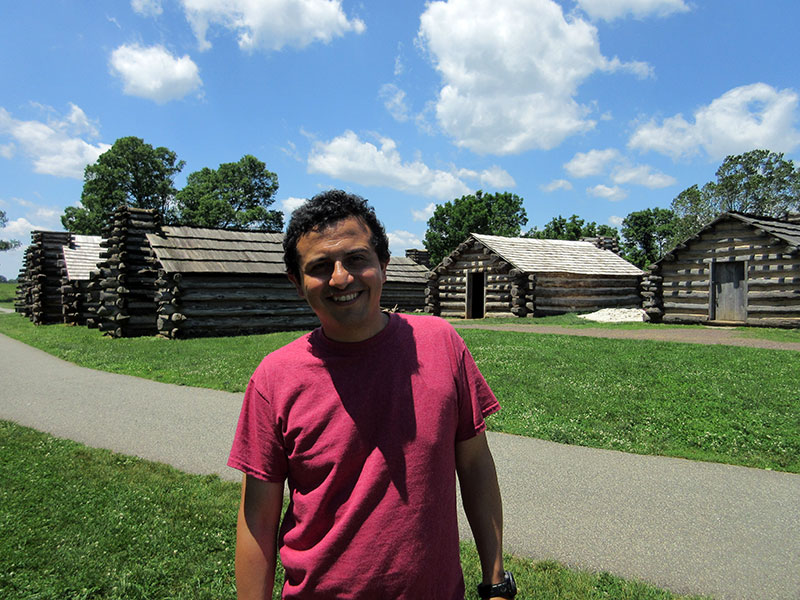 Among the numerous stops along the looping route, we toured the reconstructed army huts to see how the men lived, then we checked out the 1917 National Memorial Arch and its inscriptions about the soldiers’ perseverance.
Among the numerous stops along the looping route, we toured the reconstructed army huts to see how the men lived, then we checked out the 1917 National Memorial Arch and its inscriptions about the soldiers’ perseverance.
 We also toured the home near the historic Valley Forge train station that General George Washington used as his headquarters that winter. We got to see the inside of the home and some of the furnishings that Washington rented during his stay there.
We also toured the home near the historic Valley Forge train station that General George Washington used as his headquarters that winter. We got to see the inside of the home and some of the furnishings that Washington rented during his stay there.
 We ended the day at the Washington Memorial Chapel, another site in the park that was not what I had anticipated. Built in 1903, the chapel did not exist during the winter encampment but instead commemorates George Washington’s achievements and early American history. Looking carefully, we noted that the stained glass windows in the small Episcopal church depict not saints or biblical scenes but rather important people and events from America’s independence movement.
We ended the day at the Washington Memorial Chapel, another site in the park that was not what I had anticipated. Built in 1903, the chapel did not exist during the winter encampment but instead commemorates George Washington’s achievements and early American history. Looking carefully, we noted that the stained glass windows in the small Episcopal church depict not saints or biblical scenes but rather important people and events from America’s independence movement.
Gettysburg
 I had slightly less fuzzy grade school memories about the Battle of Gettysburg; at least I could place it in the Civil War. Not being a fan of military history, however, I felt compelled to visit Gettysburg National Military Park in southern Pennsylvania merely as the site where President Abraham Lincoln gave his famous Gettysburg Address before the end of the Civil War. This short speech, given on Nov. 19, 1863, at a dedication of Soldiers’ National Cemetery, took only two minutes to deliver but packed a punch in reminding listeners that the thousands of soldiers killed in battle here did not die in vain. Their sacrifice, rather, would lead to a “new birth of freedom” for America.
I had slightly less fuzzy grade school memories about the Battle of Gettysburg; at least I could place it in the Civil War. Not being a fan of military history, however, I felt compelled to visit Gettysburg National Military Park in southern Pennsylvania merely as the site where President Abraham Lincoln gave his famous Gettysburg Address before the end of the Civil War. This short speech, given on Nov. 19, 1863, at a dedication of Soldiers’ National Cemetery, took only two minutes to deliver but packed a punch in reminding listeners that the thousands of soldiers killed in battle here did not die in vain. Their sacrifice, rather, would lead to a “new birth of freedom” for America.
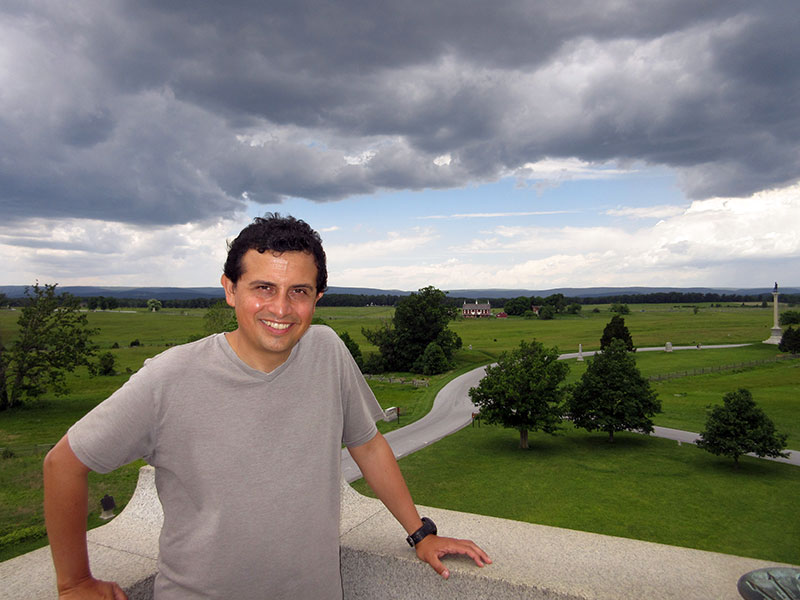 Like Valley Forge, Gettysburg sits on a large swath of rolling, grassy hills interspersed with patches of forest. The peaceful feeling conveyed in this beautiful countryside setting today belies the fierce fighting and bloodshed that took place here on July 1-3 of 1863. This park also turned out to be more interesting more than I had anticipated, both visually and historically. And it had not occurred to me on a conscious level that Confederate troops had advanced as far north as they did; I always thought of Civil War battles as taking place exclusively in the South. Unfortunately, we did not allow nearly enough time to appreciate the site of this major battle on Union soil.
Like Valley Forge, Gettysburg sits on a large swath of rolling, grassy hills interspersed with patches of forest. The peaceful feeling conveyed in this beautiful countryside setting today belies the fierce fighting and bloodshed that took place here on July 1-3 of 1863. This park also turned out to be more interesting more than I had anticipated, both visually and historically. And it had not occurred to me on a conscious level that Confederate troops had advanced as far north as they did; I always thought of Civil War battles as taking place exclusively in the South. Unfortunately, we did not allow nearly enough time to appreciate the site of this major battle on Union soil.
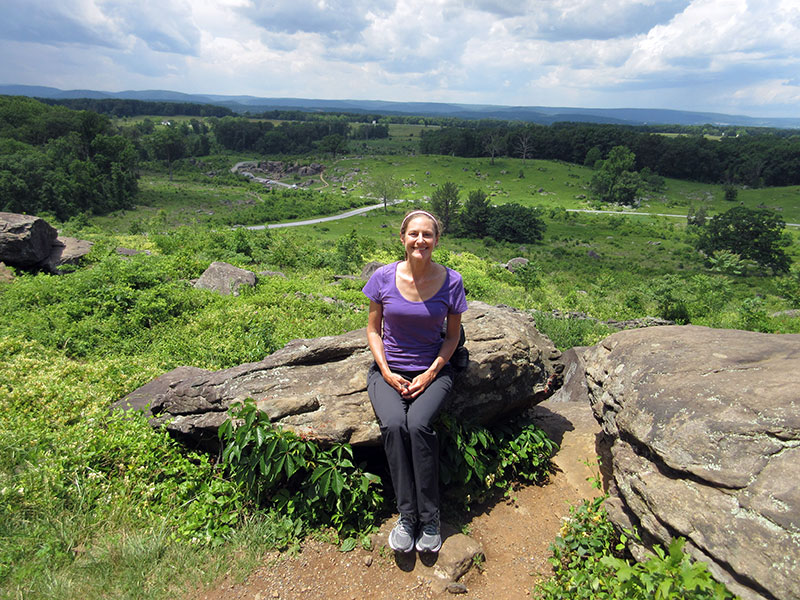 Nevertheless, we took the self-guiding auto tour route and stopped at as many of the more popular points of interest as possible. Among them were the Eternal Light Peace Memorial topped by an ever-lit flame and numerous large memorial sculptures. Little Round Top is one no-miss stop overlooking a boulder-strewn valley that witnessed the deadliest fighting on July 2. Sites within view below include The Wheatfield (where more than 4,000 men lost their lives) and The Peach Orchard (where Confederate forces eventually overran a line of Union bombardment).
Nevertheless, we took the self-guiding auto tour route and stopped at as many of the more popular points of interest as possible. Among them were the Eternal Light Peace Memorial topped by an ever-lit flame and numerous large memorial sculptures. Little Round Top is one no-miss stop overlooking a boulder-strewn valley that witnessed the deadliest fighting on July 2. Sites within view below include The Wheatfield (where more than 4,000 men lost their lives) and The Peach Orchard (where Confederate forces eventually overran a line of Union bombardment).
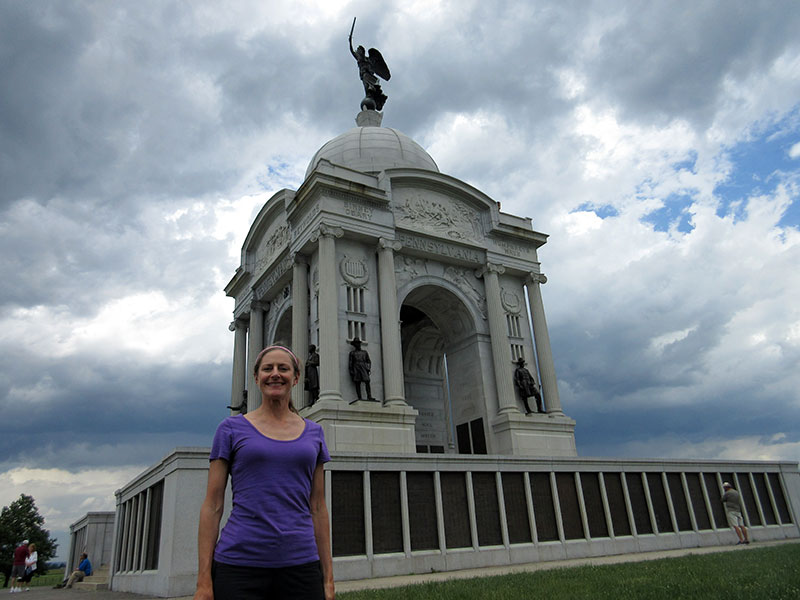 We also climbed the four-sided Pennsylvania Memorial to get a better overview of the landscape. More than a thousand smaller memorials, statues and markers dot the route, and a Civil War history buff could spend days here viewing the sculptures, reading the placards and reflecting on the events and details of the battle. In addition, the town of Gettysburg, which is surrounded by the park on three sides, has historic and picturesque value in its own right and deserves separate exploration. Sadly, being short on time, we had to breeze through much of the park so we could continue on and arrive by nightfall in Virginia at Shenandoah National Park, a destination that we’ll recap in the next segment.
We also climbed the four-sided Pennsylvania Memorial to get a better overview of the landscape. More than a thousand smaller memorials, statues and markers dot the route, and a Civil War history buff could spend days here viewing the sculptures, reading the placards and reflecting on the events and details of the battle. In addition, the town of Gettysburg, which is surrounded by the park on three sides, has historic and picturesque value in its own right and deserves separate exploration. Sadly, being short on time, we had to breeze through much of the park so we could continue on and arrive by nightfall in Virginia at Shenandoah National Park, a destination that we’ll recap in the next segment.
Beautiful place! Your awesome journey just goes on and on and on 🙂
Yep, these places are well worth adding to your list!
Wow, great history! Gen. Washington had a nice place for his headquarters, I remember reading that the soldiers during that winter had a very difficult time and nearly froze to death. Did you see the soldiers cemetery at Gettysburg? I’m having some good history lessons. Take care and keep safe!
Unfortunately we didn’t have enough time to go to the cemetery, which is one of the highlights we’ll need to go back for another time.
You know me, I spot the beautiful old homes first, so George Washington’s winter home was a favorite picture. I need to reread a book called Red Snow, it was a diary type book about the soldiers winter stay and written by a young girl who’s family did laundry for G.W. And, I also noticed you and Hector aren’t all bundled up, so the weather must be nicer.
Onward!
Our Nation’s school children would be well served with more field trips to suc important and meaningful places. Can you encourage your teacher friends to share your blog with their students?
That’s a great idea!
Wow, you two have been travelling for a long time. Do you have a Google map with stickpins for all of the places that you have visited?
We don’t have a Google Map, but we do have our progress mapped here: http://monkeyseemonkeytravel.com/project-100-progress-map/